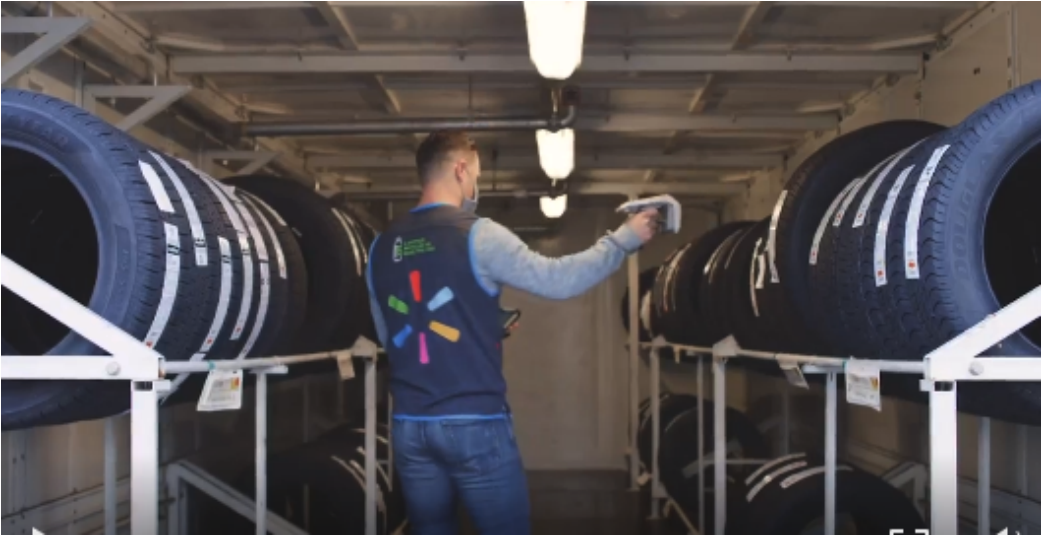
Nitheesh NH
Introduction
What’s the Story? In January 2022, Walmart announced a new requirement for its home goods and electronics suppliers, under which they must begin including RFID (radio-frequency identification) tags on all products supplied to Walmart by September 2, 2022. In 2003, Walmart became the first US mass retailer to introduce RFID technology. Following challenges including glitch concerns and patent infringement allegations, the US’s largest retailer had extended the use of RFID technology to apparel and certain electronics goods by the time of its most recent announcement. Driven by decreases in the cost of the technology and its strategic need for inventory accuracy, Walmart is once again spearheading the expansion of RFID in the retail industry. Why It Matters The new requirement will enable workers to efficiently identify and itemize inventory just by walking along their store aisles with handheld scanners. The efficiency and accuracy gains that the technology offers have grown in importance during the Covid-19 pandemic. Under lockdown restrictions, Walmart and other mass retailers saw increases in online sales and digitally originated sales—such as those fulfilled via BOPIS (buy online, pick up in-store) and curbside pickup—by swiftly integrating digital tools into the shopping experience. Walmart could turn its vast network of physical stores into fulfillment centers, withstanding the pandemic and greatly benefiting from its already impressive omnichannel system. The unprecedented rise in importance of digital sales required seamless inventory visibility. Both immediate and strategic goals have factored into Walmart’s need for better visibility of its inventory. In the short term, inventory visibility is required to improve fulfillment efficiency for online orders and to increase both online and in-store traffic. In the long term, RFID-aided inventory visibility will be crucial as Walmart seeks to forge a powerful omnichannel presence, including paid online subscription platform Walmart Plus and an emerging mobile fintech unit. [caption id="attachment_149507" align="aligncenter" width="700"] A Walmart employee using an RFID scanner to update inventory in real time
A Walmart employee using an RFID scanner to update inventory in real timeSource: Walmart[/caption]
Walmart Spearheads RFID, Again: Coresight Research Analysis
RFID Unlocks the Potential of Omnichannel The new RFID mandate will make Walmart’s omnichannel operations more seamless. Carl Douglas McMillion, President and CEO of Walmart, declared during the company’s earnings call for the fourth quarter of fiscal 2022 in February 2022 that its stores have become “hybrid,” emphasizing the importance of omnichannel seamlessness. Walmart has decided to launch its current RFID mandate following the success of RFID tagging on in-store apparel in 2020. Walmart has since seen dramatic improvements in its ability to ensure product availability, according to the company. RFID tagging resulted in improved online order fulfillment and customer satisfaction, McMillion stated. Walmart’s RFID initiative is aimed at strengthening the hybrid Walmart shopping experience through improved inventory accuracy, which the company expects to translate into greater customer satisfaction as well as more efficient use of working capital. RFID from Store Shelves to Warehouses Walmart was among the first US mass retailers to introduce RFID, which it did in 2003 amid growing interest in the technology. By the beginning of the 2010s, the development of passive RFID tags had made the technology more affordable and efficient. Between 2010 and 2013, Walmart committed itself again to RFID by tagging all menswear items. In its RFID journey, Walmart has developed its own propriety item-level RFID solutions, together with GS1 US (a nonprofit information standards organization) and the Auburn University RFID Lab. The Covid-19 pandemic—and related e-commerce acceleration—proved the urgency of Walmart’s strategic shift to utilizing RFID. Taking a customer-centric omnichannel approach, Walmart could fulfill online orders via BOPIS and curbside pickup through its network of physical stores. However, such operations require accurate inventory management and heightened inventory visibility. Adding to the urgency is Walmart’s expansion into e-commerce through Walmart Plus—notably, the latest RFID mandate covers inbound items for its e-commerce fulfillment centers. We present Walmart’s two-decade history of RFID usage in Figure 1, illustrating the challenges of being an early adopter.Figure 1. Timeline of Walmart’s Engagement with RFID
| January 2022 | Walmart US mandates suppliers in the home goods and consumer electronics categories to provide all products with RFID tags. |
| December 2020 | Walmart completes the RFID tagging of all its apparel items after a decade-long partnership with the Auburn University RFID Lab and GS1 US. |
| January 2013 | Walmart begins phasing out some RFID tagging after being named with other retailers in a series of lawsuits by RFID developer Round Rock Research over patent infringements. |
| July 2010 | Walmart begins using RFID tags on male apparel products, in the first large-scale shop-floor pilot with RFID. |
| February 2009 | Procter & Gamble abandons the RFID pilot program with Walmart. |
| March 2007 | Walmart denies a Wall Street Journal report of glitches in its RFID system. |
| March 2006 | Walmart states that RFID-tagged out-of-stock items are replenished three times faster than before, and that the manually replenished volume of out-of-stock items has fallen by 10% since the technology was introduced. |
| April 2004 | Walmart begins its first RFID trial by receiving RFID-tagged pallets from Hewlett-Packard, Johnson & Johnson, Kimberly-Clark, Kraft Foods, Nestlé Purina Petcare, Procter & Gamble and Unilever. |
| June 2003 | Walmart mandates its top 100 suppliers to attach RFID tags to all cases and pallets of inbound shipments. Additionally, bigger-ticket items such as TVs, CDs and electronic appliances must carry the tags. |
Source: Company reports/Coresight Research
Target: Comprehensive RFID Adoption Meanwhile, Target, Walmart’s rival, has comprehensively adopted RFID. After two years of exploration, in April 2017, the retailer partnered with label manufacturer Avery Dennison to deploy RFID technology to more than 1,600 stores, at a cost of $1 billion, according to Target. Keri Jones, the company’s Executive Vice President of Global Supply Chain and Operations at the time, said that the aim was to better fulfill online orders placed for store pickup. That year, 15% of Target.com purchases were fulfilled through BOPIS. Target’s e-commerce sales have since diversified to involve its website and apps and include same-day delivery. In 2021, half of all Target’s digital sales were fulfilled via same-day delivery, according to the retailer, and it claims that the inventory accuracy and visibility provided by RFID technology were crucial to this. RFID solutions have improved the integrity and visibility of Target’s supply chains, making feasible Target’s model of stores doubling as fulfillment centers or hubs. In the first quarter of fiscal 2022 (ended April 30, 2022), more than 75% of digital sales and 95% of total sales involved store inventory and in-store staff, the company reported.What We Think
Walmart’s new mandate represents a tipping point for RFID adoption among mass retailers, in which the prevalence of omnichannel initiatives call for high inventory accuracy from the store shelves to fulfillment centers to the supply chain. Implications for Brands/Retailers- Other national retailers of Walmart’s stature will be forced to follow the lead taken by their biggest rival.
- Both suppliers and manufacturers need to adopt RFID to keep up with the new needs of the mass retail industry.
- Walmart will likely remain a trailblazer of RFID in the retail industry thanks to its proprietary tags.
- The wider adoption of RFID, initiated by Walmart’s new mandate, will increase demand for the technology.
- The ever-complex supply chain ecosystem means that RFID adoption will unlock a multifaceted market, with different niches including cold-chain solutions, reverse supply chains and sustainability solutions.